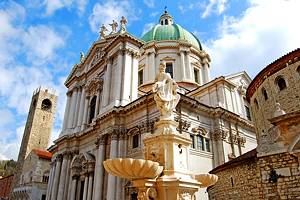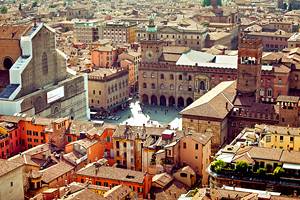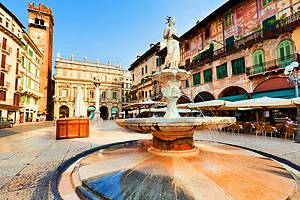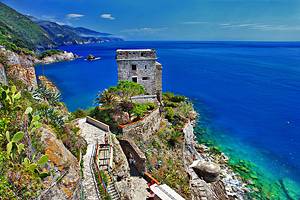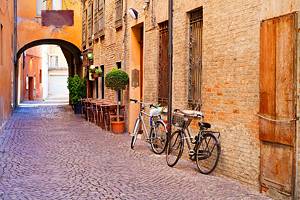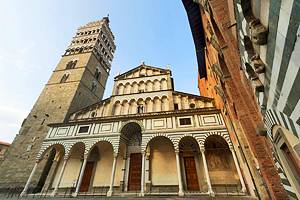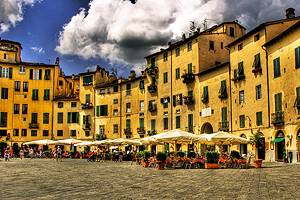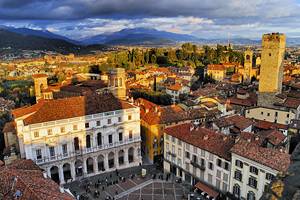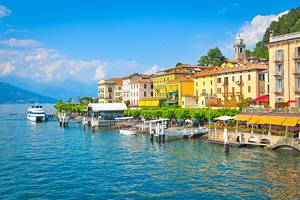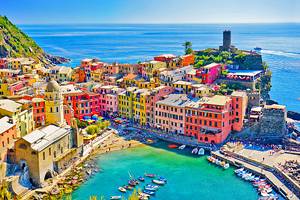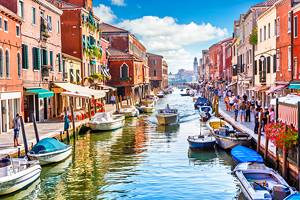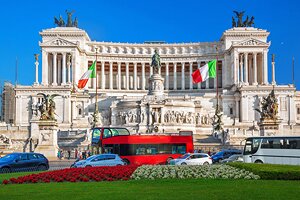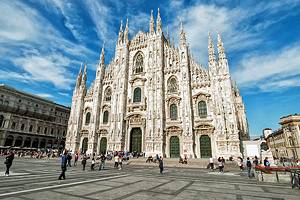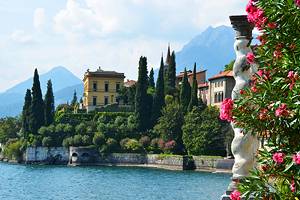Tourist Attractions in Parma
Almost nothing remains of Parma's early days as a Roman colony along the old Roman main road, the Via Aemilia; the grand palaces and elegant squares in its center speak more of its later role as the seat of the powerful Farnese dukes and its French legacy under ownership of Napoleon's wife, Marie Louise.
Foodies will recognize Parma as the home of the region's famous cheese, and one of the most popular things to do here is visit a dairy to watch master cheese-makers turning milk into Parmigiano Reggiano.
The 15th-century painter Antonio Allegri, known as Correggio, lived and worked in Parma, and visitors can still admire his work in the city's churches and museums. Music lovers come here to pay homage to two other native sons: opera composer Giuseppe Verdi, who was born in the nearby village of Roncole in 1813, and conductor Arturo Toscanini, born in Parma in 1867.
A good place to begin exploring Parma is the Piazza Garibaldi, where the 18th-century façade of the Palazzo del Governatore displays an intricate astronomical clock. Before beginning a tour, claim a table in the café that spreads across one end of the square and absorb the local scene over a cappuccino.
You'll be sure to find all the best things to do and places to visit by using this handy list of the top attractions in Parma.
- Duomo (Cathedral)
- Baptistery
- Teatro Farnese (Farnese Theater)
- Teatro Regio (Royal Theater)
- Palazzo della Pilotta and National Gallery
- Camera di San Paolo
- Shrine of Santa Maria della Steccata
- San Giovanni Evangelista (St. John the Evangelist Church)
- Parco Ducale
- Castello dei Burattini
- Day Trips from Parma
- Parma Vecchia
- Map of Attractions & Things to Do in Parma
- More Things to See and Do
Duomo (Cathedral)

Filling an entire side of the Piazza del Duomo is the cathedral, a Romanesque basilica dating from the 12th century, its broad facade making an impressive ensemble with the church's 63-meter campanile and the tall octagonal baptistery just to its left.
Look up to see a huge fresco of the Assumption of the Virgin, painted inside the dome by Correggio, the premier artist of the Parma School during the Italian Renaissance. You'll find more Renaissance art in the side chapels, then be sure to descend into the crypt to see the beautiful pillars and early Christian floor mosaics.
Address: Piazza del Duomo, Parma
Baptistery

To the right of the cathedral in Piazza del Duomo, the massive octagonal marble Baptistery was begun in the Romanesque style in 1196 by Benedetto Antelami, who completed the biblical reliefs carved on the doorways.
The building was finally completed in Gothic style almost a century later; it is one of Italy's best examples of the transition between these two very different styles. Inside are colorful frescoes and more 13th-century reliefs. Even those who don't normally like religious art, must admit this is an impressive building.
Address: Piazza del Duomo, Parma
Teatro Farnese (Farnese Theater)

Inside the enormous Palazzo della Pilotta, the palace theater was built entirely in wood by a pupil of the great Italian architect Andrea Palladio. When it was built, in 1618-28, it was the largest theater in the world, with 4,500 seats. It is thought to be the first theater with a permanent proscenium arch.
Almost destroyed by World War II bombing, it was rebuilt in its original splendor and reopened in 1962. Beautiful in its exquisite simplicity, unpainted wood lines the entire theater, its surface unadorned by the gilding and stucco work found in so many great opera houses.
Address: Piazzale Marconi, Parma
Teatro Regio (Royal Theater)

However plain it may be on the outside, prepare to be wowed by the interior of one of Italy's finest theaters, the neoclassical Teatro Regio. It was the marvel of its day when it was built in 1829 as the Ducal Theatre.
Singers and musicians may appreciate it less, considering its reputation as holding the toughest audience in Italy, especially for the works of native son, Giuseppe Verdi. Because of the Verdi connection, Parma attracts opera lovers from around the world during its season, from January through early April, and in September and October for the annual Verdi festival.
In addition to opera, there are occasional Sunday concerts. Guided backstage tours (90 minutes) include the wardrobe laboratory, set-painting lab, orchestra rehearsal room, dressing rooms, and the stage, none of which is normally open to the public.
Address: Strada Garibaldi 16, Parma
Official site: https://teatroregioparma.it
Palazzo della Pilotta and National Gallery

Facing Piazzale Marconi, Palazzo della Pilotta is a huge brick building begun in 1583 and left unfinished. The courtyard is so big that it was once used as a ball court. Inside the sprawling palace, are national museums of art and archaeology; a printing museum; a historic theater; and the beautiful library, Biblioteca Palatina.
Galleria Nazionale holds important works by Correggio (Madonna del San Girolamo and Madonna della Scodella), Parmigianino, Fra Angelico, Cima da Conegliano, Tiepolo, Canaletto, Carracci, and El Greco, plus a drawing by Leonardo da Vinci. This is a great low-key place to see the work of a wide range of artists from Italy without spending all day.
Address: Piazzale Marconi, Parma
Camera di San Paolo
In a former Benedictine convent near the Piazzale Marconi, the Camera di San Paolo is lined with well-preserved frescoes by the Renaissance master Antonio da Correggio, a native of Emilia-Romagna. The frescoes were commissioned by the Abbess Giovanna Piacenza to decorate her private quarters.
Painted in the early years of his career, between 1518 and 1519, these surprisingly bright paintings include non-religious subjects such as Diana, the Goddess of Love, along with plenty of Correggio's signature putti with their cherubic faces.
Address: Via Melloni 3, Parma
Shrine of Santa Maria della Steccata

The Renaissance church was built between 1521 and 1539 to house a venerated image of St. John the Baptist and an equally miraculous statue of the Virgin and child. A number of local and other artists worked on the richly decorated interior, including the young Parmigianino, who did many of the frescoes.
The large fresco in the apse depicting the Coronation of the Virgin with Saints was painted in 1541 by Michelangelo Anselmi. Panels on the wall beside the image of the Virgin hold votive offerings in thanks for prayers granted.
Address: Strada Giuseppe Garibaldi, Parma
San Giovanni Evangelista (St. John the Evangelist Church)

Behind Parma's cathedral, the convent church of San Giovanni Evangelista is a Renaissance building (1510) with a Baroque façade added a century later. In the dome are more frescoes painted by Correggio and his pupil Parmigianino in 1521-23.
Stop by the adjoining convent to see the Storica Farmacia di San Giovanni Evangelista, a charming old apothecary shop, with a Renaissance interior where monks sell cough drops, creams, and other herbal products. Such pharmacies were once common in monasteries, but relatively few remain today.
Address: Piazzale San Giovanni 1, Parma
Parco Ducale

The large Parco Ducale was once the grounds and gardens of the grand 16th-century Palazzo Ducale, the ducal palace. Originally a mix of French- and Italian-style landscape garden, with later changes by Duchess Marie Louise, the garden was badly damaged in World War II. Recent restorations have recreated the parterres and fountains of the Farnese period.
On a guided tour of the Ducal Palace, you can see the Piano Nobile (the richly decorated main floor), Ferdinando di Borbone's New Apartment, and Ducal Chapel of Saint Liborio.
Today, the peaceful riverside park is well used by locals and a favorite place for tourists to stroll along the river to the Palazzo Ducale or sit on benches and watch the world go by. It's also a favorite place for picnics (pick up some of the region's famous cheese in one of the little shops).
Official site: http://reggiadicolorno.it/en/
Castello dei Burattini

Four generations of the Ferrari family of Parma have carved, painted, strung, and dressed puppets by hand, and this free museum beside the Camera di San Paolo, on the ground floor of the Monastery of San Paolo, displays those and other marionettes from elsewhere in Italy.
In each room, a little theater displays the marionettes, surrounded by more exhibits of puppets, playbills, posters, photographs, and stage equipment. Faces and costumes are all designed individually to suit the characters in the stories, which are also created here. So are the stage sets and props. You can watch films of past puppet shows produced by the Ferraris.
Address: Via Melloni 3, Parma
Official site: http://www.castellodeiburattini.it/
Day Trips from Parma

Two nearby towns are interesting places to visit on day trips from Parma. About 16 kilometers away, the Apennine village of Torrechiara is topped by a large 15th-century castle, magnificently situated above the valley. It is one of the region's best preserved castles.
Northeast of Parma, the little town of Sabbioneta is interesting because it was built as a model princely residence and declared a UNESCO World Heritage site as a perfect example of Renaissance urban planning theories, complete with fortifications, palaces, a church, and an unusual theater that now hosts summer performances.
Parma Vecchia

Across the Parma River from its compact center lies the old town, Parma Vecchia. To get there from Piazza Garibaldi, follow Strada Mazzini west across the Ponte di Mezzo, where you might be able to identify parts of the old Roman bridge in the underpass.
Almost straight ahead, the unusually shaped Baroque church of Santissima Annunziata was built in 1566 with a boldly designed dome. Other attractions of interest to tourists are the Romanesque church of Santa Croce, with good 17th-century frescoes. At Borgo Rodolfo Tanzi 13 is the house where the famous conductor Arturo Toscanini was born in 1867.
Map of Attractions & Things to Do in Parma
More Things to See and Do
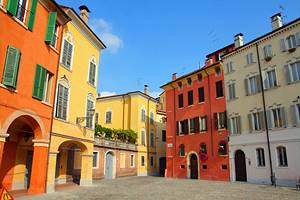
Where to Go near Parma: Parma is in the Po Valley alongside the major Autostrada that leads southeast to Bologna, Italy's culinary capital. But before you reach Bologna, stop to see Modena, where you can visit the Ferrari Museum and the Villa of Luciano Pavarotti.

Places to Go from Parma: Heading north through the Renaissance town of Mantova, where you'll want to tour the resplendent Ducal Palace, you can visit romantic Verona, with a well-preserved Roman Arena at its center. Beyond is the summer playground of Lake Garda and its beautiful lakeside towns.





